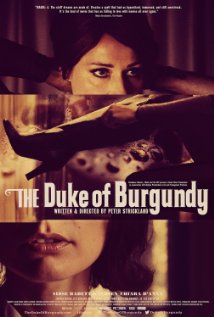
By Allegra Howard
Interspersed with sequences of intense psychosexual anxiety and humorous insight, The Duke of Burgundy is a lush, sensual and humanizing portrait of the BDSM relationship between entomology scholar Cynthia (Sidse Babett Knudsen, Borgen) and her young lover Evelyn (Chiara D’Anna, Berberian Sound Studio) as they attempt to reconcile their very different intimate needs.
The opening sequence establishes Evelyn as a meek and naïve girl who housecleans for Cynthia, the seemingly austere and domineering mistress of a sumptuous home in a beautiful autumnal forest. Cynthia severely reprimands and punishes Evelyn for even the slightest infractions, but the following scene of them cuddling in bed exposes that they had merely been roleplaying Evelyn’s fantasy.
In fact, Evelyn is actually the more dominant partner: Not only does she demand that Cynthia role-play as a domineering mistress, but she also demands that Cynthia role-play exactly as her meticulously detailed instructions dictate. As Evelyn’s requests grow more extreme, Cynthia finds herself more hard-pressed to satisfy her partner. As Cynthia begins to feel inadequate and even unloved, she and the audience question whether she and Evelyn are meant to be together.
As sensual and, as critic Leslie Felperin phrases it, “visually ravishing” as The Duke of Burgundy is, the movie is not very explicit: Its few sex scenes are brief and obscured, often off-screen entirely. The movie instead focuses on being emotionally evocative, drawing on a wide range of influences that make the sections of the movie feel undeniably disparate. Nonetheless, the focus on Cynthia’s and Evelyn’s relationship keeps the movie coherent.
Towards the end, the film references the experimental short film Mothlight (1963), which is particularly noteworthy since it uses The Duke of Burgundy’s most significant motif — moths — to create the suffocating anxiety that defines the main conflict of the movie. Insects may seem too creepy a motif for such a sensual movie, but their inclusion nonetheless makes the film very tactile.
Despite its artistry, the movie is not too highbrow for the average moviegoer to enjoy. In fact, The Duke of Burgundy employs a sense of humor like that of BBC’s domestic sitcom “Terry and June” to humanize the unconventional relationship. Even so, The Duke of Burgundy remains a fantasy since Cynthia and Evelyn are only normalized in the context of a fairytale. Depicting lesbians as subjects of a fantasy could be problematic, but The Duke of Burgundy remains a beautiful and enchanting film well-worth watching.







































































































































































































